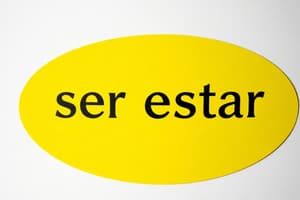Podcast
Questions and Answers
What influences articles, adjectives, and pronouns in Spanish grammar?
What influences articles, adjectives, and pronouns in Spanish grammar?
Which of the following sentences correctly describes the sentence structure used in Spanish?
Which of the following sentences correctly describes the sentence structure used in Spanish?
What is a significant feature of the Spanish language concerning its vocabulary sources?
What is a significant feature of the Spanish language concerning its vocabulary sources?
Which aspect of Spanish verbs varies considerably according to the tense?
Which aspect of Spanish verbs varies considerably according to the tense?
Signup and view all the answers
What does the subjunctive mood in Spanish typically express?
What does the subjunctive mood in Spanish typically express?
Signup and view all the answers
Study Notes
Spanish Language Overview
- Spanish is a Romance language, stemming from Vulgar Latin.
- It's the fourth most spoken language globally, after Mandarin Chinese, English, and Hindi.
- Over 500 million speakers use Spanish as their native or second language.
- Spanish is the official language of 20 countries.
- Key variations in Spanish exist across different regions and countries, including pronunciation, vocabulary, and grammar nuances.
- Spanish uses the Latin alphabet, with some diacritics, like the acute accent (á, é, í, ó, ú).
Spanish Grammar Overview
- Spanish is a highly inflected language.
- Noun gender and number influence the articles, adjectives, and pronouns.
- Spanish uses a subject-verb-object sentence structure, although this can vary based on the type of sentence.
- Verbs conjugate based on the person, number, and tense.
- The use of prepositions is crucial in Spanish grammar, as in other languages, and can dramatically change the meaning of a sentence.
- Verb conjugation varies considerably according to the tense (e.g., present, past, future, imperfect...).
- The subjunctive mood expresses uncertainty, possibility, or desire.
- The use of the definite and indefinite articles follows specific grammatical rules.
Spanish Vocabulary
- Spanish vocabulary has a rich history, drawing from Latin, Arabic, and indigenous languages.
- Many loanwords exist, especially in areas with strong historical ties to other cultures and languages.
- Spanish has cognates with many other Romance languages, making vocabulary acquisition easier for Spanish speakers learning languages like Italian or French.
- Formal and informal vocabulary often exists for certain terms.
- Regional variations in vocabulary often exist.
Studying That Suits You
Use AI to generate personalized quizzes and flashcards to suit your learning preferences.
Description
This quiz covers the fundamentals of the Spanish language, including its origins, global prevalence, and regional variations. It also delves into Spanish grammar, focusing on noun gender, sentence structure, and verb conjugation. Test your knowledge on the key elements that make Spanish a distinct and widely spoken language.




